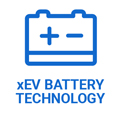
Cambridge EnerTech’s
xEV Battery Technology, Application, and Market
Driving the Future Growth of Electric Vehicles Globally
21-22 June 2023
With the significant expansion of vehicle electrification across the globe, automakers are scrambling to develop the vehicles that will not only meet the upcoming stringent emission regulations, but also attract customers and provide viable financial
return. In addition, to meet the automakers requirements, the industry must deliver on lower costs, higher energy densities, fast charging, as well as safety and durability. This conference will address the trends, challenges and opportunities that
will drive future growth and how the key players are achieving success.